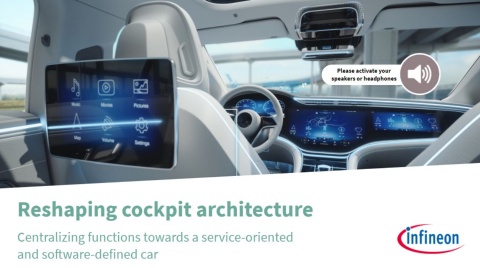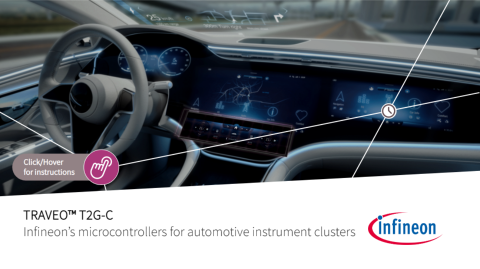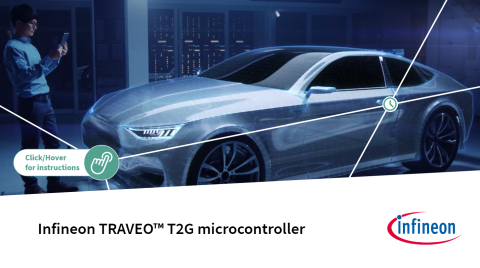TRAVEO™ T2G CYT4DN
TRAVEO™ T2G CYT4DN は、低消費電力とメモリを使用しながら、高いディスプレイ解像度、優れたパフォーマンス、動的コンテンツを備えた複数のディスプレイを提供します
TRAVEO™ T2G CYT4DN は、インストルメントクラスターやヘッドアップディスプレイ(HUD) などの車載アプリケーション向けに設計された最先端マイクロコントローラーファミリーです。メインタスク用の強力な320 MHz Arm® Cortex®-M7 CPU、周辺機器とセキュリティ (HSM) 専用Arm® Cortex®-M0+ CPUを備えたこのファミリーは、卓越したパフォーマンスを提供します。
6 MBのフラッシュ、640 KBのRAM、128 KBのワークフラッシュを搭載し、動作電圧は2.7 V〜5.5 Vです。
TRAVEO™ T2G CYT4DN ファミリーは、ギガビットイーサネット、4チャネルCAN FD、最大12チャネルSCB、2チャネルLIN-UART など、幅広いインターフェースを提供します。さまざまなモードをサポートする2チャネルSMIF も備えています。2.5D エンジン、4 MB VRAM、ベクトル描画、JPEG デコード、多用途のビデオ入力およびビデオ出力オプションにより、クラスター機能が強化されます。本ファミリーは、サウンドモジュール、PCM-PWM、I2S、DAC、6チャネルSMC + ZPDなどのオーディオ機能をサポートしています。
TRAVEO™ T2G CYT4DNファミリーは、17 mm × 17 mm × 1.70 mmの327-BGA パッケージで提供され、設計の柔軟性を保証します。 組み込みペリフェラルを介してさまざまな車載システムとシームレスに統合され、CAN FD、LIN、CXPI、イーサネットなどのプロトコルをサポートします。
主な特長
- 320MHz Arm® Cortex®-M7+Cortex®-M0+
- 2.5Dエンジン、720p GFX、4x MB VRAM
- 6-ch SMC + ZPD、ギガビットイーサネット
- 16ビットモーターTCPWM
- 最大6MBフラッシュ、640KB SRAM
- 1xビデオ入力、2x ビデオ出力、HYPERBUS™
- ベクター画像、JPEGデコーダー
- パッケージ: 327-BGA
- 640KB SRAM
- 最大48x ADCチャネル、168x GPIO
- サウンドモジュール、PCM-PWM、I2S、DAC
- Sグレード温度–40°C〜105°C
TRAVEO™ T2G CYT4DNの主な利点
TRAVEO™ T2G CYT4DNは、強化された2.5Dグラフィックスエンジンを搭載し、HD解像度で最大720pのシングルチップ ソリューションを提供します。 オンザフライ レンダリング モードとハードウェア解凍により、ハイエンドの3D SoCや複雑なソフトウェアなしで、最もコスト効率の高いスマートコックピットが可能になります。 また、独自の電圧領域を備えたクラス最高の専用スタンバイ モード コントローラーを備えており、低電力モードをサポートするだけでなく、マイクロコントローラーの残りの部分がスタンバイ状態にある間に、アナログ測定、CANおよびLIN通信、RTC、基本処理などの特定の動作も実行できます。
安全性はインフィニオンのコアとなるノウハウであり、すべての製品に安全メカニズム(MBIST、ECCフラッシュ/RAM、CRCを含む)が搭載されており、ASIL-B ISO 26262をサポートする安全プラットフォームを確保しています。 専用のArm® Cortex-M0+コアとセキュリティハードウェアによるセキュアブートサポートによる最先端のセキュリティにより、暗号化機能を高速化します。
セキュリティ面では、HSM準拠のeVitaをフル装備し、将来を見据えたセキュリティ対策を実現しています。 さらに、4つのCAN FD、2つのLIN、2つのSPIと、1つのGbit Ethernet と2つのCXPIなど、新しい高速通信インターフェースとの広範な接続性を提供します。
インフィニオンのHMI ツール認定プログラムは、高度なTRAVEO™ T2G グラフィックスコントローラーとともにHMI ツールを採用する際のユーザーエクスペリエンスを向上させるために細心の注意を払って作成されています。 インフィニオンのHMI ツール認証の基準を満たすパートナーは、インフィニオンのリファレンスユースケースとの統合について、完全な共同テストと評価を受けています。
このコラボレーション手法を通じて、インフィニオンは、HMI ツールが当社のマイクロコントローラーの主要なハードウェア機能とシームレスに連携する信頼できるパートナーのネットワークを確立することを目指しています。 TRAVEO™ T2G グラフィックスコントローラーとこれらの認定HMI ツールを組み合わせることで、お客様は自信を持ってアプリケーションを最適化して最高のパフォーマンスを得ることができます。
当社のTRAVEO™ T2Gプリファード デザインハウスは、信頼できるパートナーのエコシステムであり、お客様固有のニーズに合わせてノウハウを調整することでサポートを拡大します。
認定されたプリファードデザインハウスとパートナーシップを組むことで、専門家のアドバイスとお客様の目標を達成するためにカスタマイズされたサポートを受けることができます。当社の専門家チームは、お客様サービスに付加価値をもたらし、協力して設計を最適化し、ビジネス目標の成功を支援します。
インフィニオンは、お客様一人ひとりが異なることを理解しているため、お客様の特定のニーズに合わせたソリューションを提供しています。 製品に特化したサポートからアプリケーション固有のアドバイスまで、インフィニオンのプリファードデザインハウスは、TRAVEO™ T2Gを使用するための十分なトレーニングを受けており、お客様の成功を支援する豊富な知識と専門知識を提供します。
パートナーとともに、インフィニオンの製品を使用するシステムに最適なカスタマーサポートを提供します。 インフィニオンのプリファードデザインハウスは、お客様の成功を確実にするために、卓越したサービスとサポートを提供することをお約束します。迷う必要はありません。目標を達成し、ビジネスを次のレベルに引き上げましょう。
ModusToolbox™
ModusToolbox™ソフトウェアは、このような柔軟で効率的な開発環境を提供する開発ツールと組み込みランタイム資産の包括的なスイートです。ModusToolbox™ソフトウェアは、最初のスタートアップセットアップから、プロトタイプ作成の編集、コンパイル、デバッグのサイクルを経て、最終的に組み込みアプリケーションの最終的なハードウェアへのリターゲティングまでのシームレスな移行をサポートする特定のツールと機能を提供します。 この開発環境は、 TRAVEO™ T2G Arm® Cortex®マイクロコントローラー と PSoC™ Arm® Cortex®マイクロコントローラーをサポートしています。
インフィニオンのTRAVEO™ T2G AUTOSARソフトウェア
TRAVEO™ AUTOSARソフトウェアは2014年に市場に投入されて以来、数多くの改良とアップグレードが行われてきました。 TRAVEO™ T2Gでは、社内のTRAVEO™エキスパートが開発、保守、サポートを行う、成熟した機能豊富なドライバ レイヤーが利用可能になりました。 TRAVEO™ T2G AUTOSARソフトウェアは、AUTOMOTIVE SPICEおよびISO26262規格に準拠して開発されているため、ASIL-Bまでの安全目標を持つアプリケーションに適しています。 さらに、納品パッケージには、ノードロックライセンスが付属する EB Tresos™ 設定ツールが含まれています。
TRAVEO™ のその他の技術文書へのアクセス
myInfineon Collaboration Platform (myICP) に登録すると、マイクロコントローラーに関する追加情報 (技術ドキュメント、トレーニング、ツールなど) にアクセスできます。 以下の手順で始めましょう。
- こちらからmyInfineonに登録してください
- アクセスリクエストを traveo@infineon.com に送信してください (あなたの会社のメールアドレスを使用)。
- 新しいアクセスの使用方法を説明する確認メールが届きます。
TRAVEO™ T2G CYT4DN Block Diagram
オンライントレーニング / eラーニング
- ダイレクトメモリアクセス (DMA) は、CPUを介さずに効率的なデータ転送と管理を行うことのできる重要技術です
- DMAの転送モードを理解し、DMAの基本的な使用例を学びましょう
- プロセッサ間通信 (IPC) の機能について
- プロセッサ間通信 (IPC) の基本的な使用事例を紹介

- MCUコンパニオンを定義し、それらが扱う課題を取り上げて、ユースケースを何例か説明します。
- インフィニオンの車載用マイクロコントローラーの詳細について

- コックピットアーキテクチャの進化を理解する
- ヘッドユニットやコックピットドメインコントローラなどのセントラルモジュールの重要性を理解し、インフィニオンのソリューションとそのコンポーネントについて把握する

- AURIX™ TC3xx およびTRAVEO™ T2GでのEthernetインターフェースの基本動作についてご覧ください
- TSN (Time-Sensitive Networking) 機能が両世代の派生製品でサポートされているかを確認してください

- 今日の自動車に共通するセキュリティ脅威を特定
- OPTIGA™ TPMが自動車システムの高度なセキュリティを実現する方法と、さまざまなホスト環境でのさまざまなユースケースでのアプリケーションを理解

-
インフィニオンのTRAVEO™ T2Gマイクロコントローラーの主な特長を説明
-
本製品ファミリーを構成するさまざまなバリエーションについて紹介

- インフィニオンには、長きにわたりディスプレイを搭載した自動車用の各種グラフィックアプリケーションをサポートしてきた実績があります
インフィニオンのTRAVEO™ T2Gマイクロコントローラーは、システムオンチップソリューションよりも、車載用ディスプレイのサイズの制約への対応や、コスト削減、性能および帯域幅を向上するよう設計されています

このトレーニングでは、ボディおよびグラフィックアプリケーション向けのTRAVEO™ T2G製品のラインアップ、また、主な特長、安全機能、開発キットについてご紹介し、後半ではTRAVEO™の車載ソフトウェア、ツールパートナー エコシステムについてもご説明します。
TRAVEO™ T2Gプロテクション ユニットは堅牢なセキュリティと保護で、不正アクセスや意図しないアクセスから保護します。
TRAVEO™ T2G フォルト サブシステムでは、マイクロコントローラー システムに発生したフォルトを検出および診断することができます。




